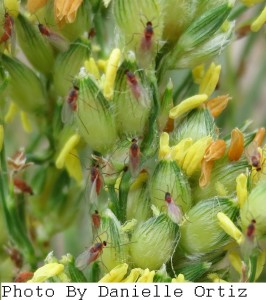In the grain sorghum fields of the Mid-Coast, we continue to find sorghum midge, stink bugs, headworms and both sugarcane and yellow sugarcane aphids. 10-20% of the fields have one or more insects at or above economic levels.
Many grain sorghum fields in the Mid-Coast have plants with maturity that can range from boot to soft dough. In some fields these different maturities are in different parts of the fields while other fields have these plants all with in 20 feet of each other. Many of these fields also have midge, stink bugs and/or headworms. Determining the economic threshold in these fields is a considerable challenge because not all of the plants are susceptible to midge, stink bugs or headworms. Blooming heads are susceptible to midge and heads at or beyond bloom are susceptible to stink bugs and headworms.
To help with determining the proper economic threshold, we must determine the number of susceptible heads per acre for each pest. When visiting these fields, measure 10 feet of row and count the number of heads in bloom (for midge), and the number of heads in bloom or beyond (for stink bugs and headworms). This count should be done in as 5-10 places in the field depending on field size and can be done while looking for the pest insects. Larger fields require more locations.
Divide this number of heads by 10 and multiply by the number of row feet per acre for your row width (Table 1). You can then use the number of susceptible heads per acre to calculate the economic threshold for the insect pest in question HERE.
Once you have determined the economic threshold, you can determine if the field requires treatment for one of these pests. Assuming the cost of insecticide for a pyrethroid application is $3, add the cost of application. I use $3 for a ground application and $6 for aerial application and a grain value of $7.
If a field has 30,000 susceptible heads in bloom, the treatment threshold for midge is 0.95 per head for ground application and 1.43 by air. Stink bugs ET is 0.88 by ground and 1.31 by air. And headworm ET is 1.47 Medium worms and 0.28 Large worms by ground or 2.2 medium and 0.42 large worms by air.
However, for a more uniform field with 60,000 susceptible heads in bloom, the treatment threshold for midge is 0.48 per head for ground application and 0.71 by air. Stink bugs ET is 0.44 by ground and 0.66 by air. And headworm ET is 0.73 Medium worms and 0.14 Large worms by ground or 1.1 medium and 0.21 large worms by air.
The next question is what if we have multiple pests below threshold? In this case, consider the percentage of ET for each pest and add the percentages together. If they exceed 100% ET then treat the field.
For example, if we have 0.5 midge per head and 0.5 stink bugs per head, the percentage ET for a ground application in the above example would be (30,000 heads per acre):
(0.5 midge / 0.95) + (0.5 stink bugs / 0.88) = 1.09
In this example, I would treat the field because the ET of the two pests is greater than 1.
